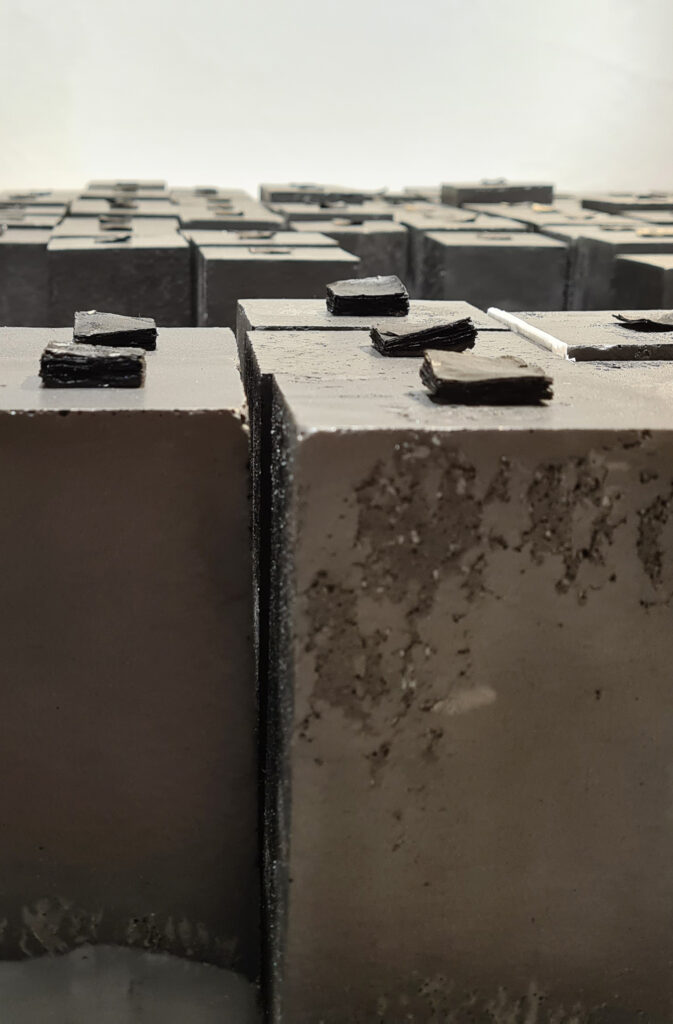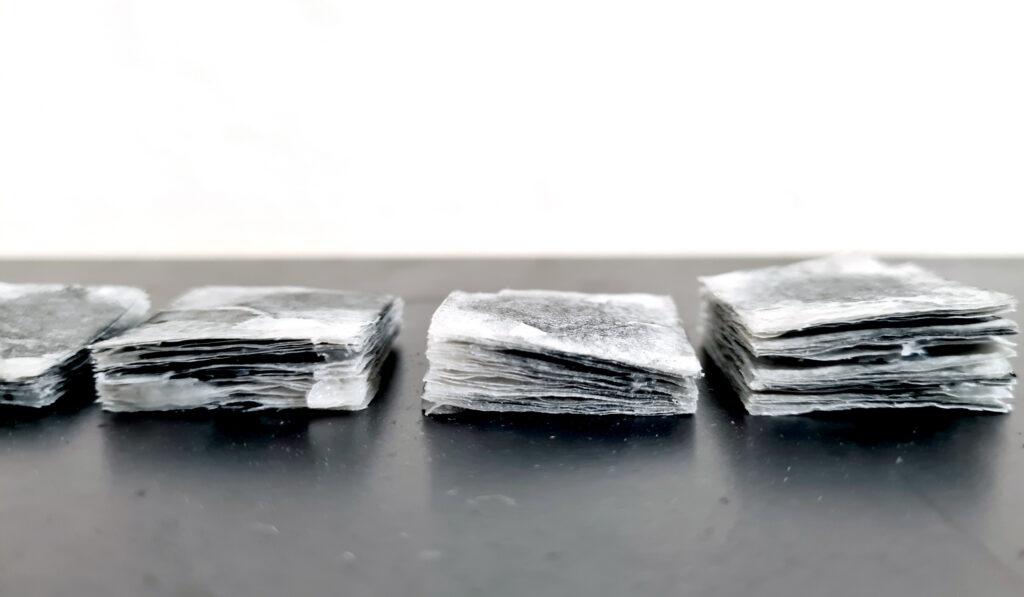For Laura Mesa, drawing is a reflective medium with which to rethink the relationships between the real and its representation. Through this argumentative strategy, the artist creates pieces that become metaphors, as she follows through to the very end her interest in reflecting on the status of the image in the midst of the crisis facing contemporary representation. To this end, she questions the usual practice of this medium and prefers instead to break it down into its constituent parts — paper, graphite, and ink — to work with them in all their materiality. Her drawings occupy spaces, develop volumetrically and, above all, contain no trace of classical illusionism. Also, the certainty that any kind of image is not a faithful reflection of reality but the construction of reality itself allows the artist, by extension, to examine how the representation we make of the world through theories and concepts builds reality itself and not vice versa.
But not the world is made up of more than 27,000 small pieces of tissue paper. Arranged in varying numbers of layers, these stacks of paper make up the 745 pieces that form the starting point of this exhibition, since each one has a double created in graphite, and some of them also have a double created in ink located on graphite prisms. The fact that the number of pieces included in the exhibition is 745 is not random; rather, it responds to data published by the UN in 2017 on birth parameters, life expectancy, urban population and the world heritage of the 217 recognised countries. What we see, therefore, is not an interpretation: each piece draws and represents a country and acts as a real image of it by transposing the data contained in each indicator into a volumetric drawing. Following this constructive logic, if, say, a country has five points on the human development index of the birth rate, that country will be represented by five layers of tissue paper.

But not the world is, therefore, cartography unfurled through drawing. We can, for example, map a territory by delimiting a space that we separate from the rest. By demarcating an area, we are stating its difference from the environment it doesn’t contain and we inscribe it as an independent entity with characteristics that determine it as a country. But we can also map our mental and conceptual schemes from which we generate definitions and reasoning that allow us to organise and understand the reality around us. When Laura Mesa wonders about our knowledge of the global world and turns to given concepts or statistical data for an answer, she is questioning precisely the extent to which the parameters used by social sciences provide a true understanding of the world — birth rate, death rate, level of education, per capita income, or GDP, among others — and the extent to which the use of statistical data provides the intended objective vision of reality. If we look at the first question, the variables that point to the different standards of living in society are expected to be truthful and total, as they generate a global vision of the collectivity of each country. However, in the space of our own subjectivity, the quantification of such criteria seems to offer us a meagre explanation of what truly concerns us and models us as contemporary subjects. Furthermore, the accumulation of data as an objective reflection of what we are becomes a cold specular image that says little about us.
It is at this point that Laura Mesa’s work becomes an exercise in resistance, since her own creative process seeks to give body and consistency to the experience of the subjective through the practice of drawing. If we stop to examine each of the pieces formed by the stacks of paper, we see that these have required active bodily participation by the artist through the repeated gesture.
Each piece has been cut, diligently — one by one, sheet by sheet — repeating a silent choreography in which the paper no longer acts as a mere medium that simply keeps or records the graphite line. Now, paper takes on an absolute autonomy, being in itself a complete and finished drawing and, in the very process of obtaining, the artist recalls — sheet by sheet — that individual experience cannot be blurred by globalising concepts that account for the collective in the world. Action, time, and body are thus combined in Laura Mesa’s drawings, contravening the traditional definition of that language. Indeed, for centuries, drawing was considered a subsidiary tool whose function was to pin down an idea that would then be brought into being through the higher arts such as painting, sculpture, or architecture. Finally, with the advent of modernity, drawing obtained full citizenship and was even used by many artists as a more direct, personal, and instantaneous medium of expression, freeing them from the rigid structures of the academy.

Laura Mesa picks up this baton, but she also uses the exercise of drawing as expertise and skill to question its own definition and consideration. Each of her pieces, therefore, acquires an important conceptual charge by redefining its artistic position, turning drawing into a manual and even artisan process. Her meticulous brittle work draws on series and repetition, but she does not rely on mechanical processes that seek to feint the artist’s hand; on the contrary, repeating the same gesture makes the key difference that, in her case, she deliberately wants to make visible. And thus, through the repeated gesture of her hand, and her mind, the artist keeps remembering that, faced with the technification of the contemporary world, the homogenisation of thought, the superficiality of capitalist practice, and the coldness of data, her action becomes a kind of resistance, resituated within the space of the intimate and the corporeal.
These two procedures, series and repetition, are combined with a third process: settling. The accommodation of each of the sheets of paper in layers is transformed into a compacted image when the artist creates doubles in graphite or ink. The lightness of cellulose contrasts with the solidity offered by the vision of these materials, referring us to infinite process of layering and sedimentation that makes up our structures of thought and discernment about the world. The robustness of these vulnerable pieces alludes to the construction process through which we build knowledge about reality, creating on occasion systems and configurations that are seen as immovable. The question, therefore, would be: Are the definitions that we have about the world ‘a priori’ or, rather, on the contrary, constructions made by subjects through which we give meaning to the world, and as constructs, subjected to changes and reformulations? The perspicacity of such a question is resolved in the materiality of these drawings/objects. The fragility of the materials and the economy of the media point to and evidence the problems of representation — both of the image and of our mental schemes —, and in the very contradiction or ambivalence between the livid and the compact, Laura Mesa reiterates that the permanence and anchoring she achieves during the production of her work are at tension with the weakness of a world that, like its materials, is somewhere between transitory and settled. Hence, following Habermas’s school of thought, we might suppose that thinking about the end compromises the end, but not the world.
Verónica Farizo
The artist talks with Verónica Farizo about her work and the exhibition Pero no el mundo.